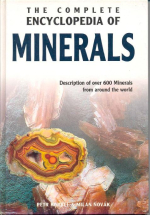Добрый день, Коллеги. Важное сообщение, просьба принять участие. Музей Ферсмана ищет помощь для реставрационных работ в помещении. Подробности по ссылке
The complete encyclopedia of minerals. Description of over 600 minerals from around the world / Полная энциклопедия минералов. Описание более 600 минералов со всего мира
The ever increasing number of publications about minerals reflects a growing interest in nature. Most of those publications though only deal with a few dozen of the most common minerals or gemstones. This book fills the gap by also featuring less common and rare minerals. The authors describe over 600 mineral species and varieties, illustrated with about 750 color photographs. In choosing illustrations of particular minerals, aesthetic criteria such as size of crystal and color played a role in addition to their importance and distribution in nature. This book includes some rare minerals, known only from one locality, because they form very attractive crystals or aggregates. There are minerals known to humankind since prehistoric times such as quartz and gold, but also minerals first described quite recently like rossmanite. The photographs show well-formed and colorful crystals but many-aggregates, which are more common in nature, are also included. The minerals in the book are listed according to the mincralogical system of Hugo Strunz, in his book Mineralogische Tabellen in 1978. The chemical formulae of individual minerals follow the form of Glossary of Mineral Species 1995 by M. Fleischer and J.A. Mandarine The information is complemented in both cases with the latest knowledge from scientific literature, such as new nomenclature of amphiboles, micas and zeolites. The mineral descriptions cover the basic physical and chemical data, including chemical formula and crystal system. The data provided correspond mainly to the end-members. The less common valence of the chemical elements is marked in the chemical formula (FeJ, Mn", As", Mn4", Pb'). Where an element features in both valences in the mineral, they are both marked (e.g. ilvaite, braunite).
The origin of individual minerals is described in detail. We chose for a relatively simplified scheme because the normal complexity cannot be described here in detail. Minerals can be distinguished as either primary (resulting directly from a solidifying of magma, crystallizing of an aqueous solution or mctamorphism - re-crystallization in a solid state) and secondary (resulting from alteration of the original mineral, e.g. during its oxidation or reduction under low temperature and pressure close to the surface of the Earth). Primary minerals are divided into following groups: 1. magmatic, when a mineral crystallizes directly from a melt (it includes magmatic and effusive igneous rocks, including granitic and alkaline syenite pegmatites and meteorites); 2. sedimentary, when a mineral crystallizes during a process of diagenesis or from hydrous solutions under normal temperature (clastic, organic and chemical sedimentary rocks); 3. mctamorphic, when a mineral crystallizes during meiamorphic processes in a solid state at a wide range of temperature and pressure (it includes regionally and contact metamorphosed rocks and skarns); 4. hydrothermal, when minerals crystallize from aqueous solutions and fluids under high to low temperatures (it includes ore and the Alpine-type veins, cavities in volcanic rocks, minerals and rocks, hydrothermally altered under high temperature, e.g. greisens). Secondary minerals are divided into following groups: 1. oxidation, when minerals result from the oxidation (weathering) of the primary minerals in the oxidation zone of ore deposits and other rocks (it includes the origin of malachite and azurite during the chalcopyrile oxidation, also the origin of secondary phosphates in granitic pegmatites during the oxidation of primary phosphates); 2. cementation, when minerals result from the reduction of the primary minerals (the origin of native copper and native silver under the reduction conditions in the cementation zone of ore deposits). This classification is very much simplified of course, because in many cases we cannot readily determine a specific origin of a particular mineral. This relates to minerals that crystallize under conditions which approximately represent a transilion between separate phases of the origin, such as the magmatic or hydrothermal origins of elbaite in the pegmatite cavities: the mctamorphic or hydrothermal origins of grossular in skarns; the magmatic or metamorphic origins of cordierite in migmaiites; and the hydrothermal or secondary origins of some phosphates in granitic pegmatites etc.
With the localities for individual minerals we have tried to list the most important worldwide localities regardless of their recent production but we have also included recent discoveries since these may produce important mineral specimens. Where a mineral has an important use this is listed at the end of mineral description. We would like to acknowledge all who contributed in any way to the production of this book, particularly those private collectors and institutions which loaned minerals for photography. We hope those fascinated in the world of minerals and of nature will find this book a fascinating source of information. This book is dedicated to the memory of Dr. Jaroslav "venek, who was of extraordinary influence to several generations of Czech and Slovak mineralogists and mineral collectors with his enthusiasm for mineralogy and attitude to life. <...>




